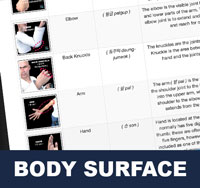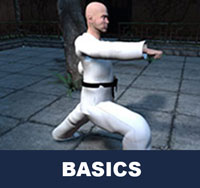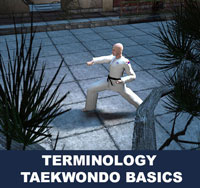Taekwondo 태권도Taekwondo Preschool
Taekwondo is known for its emphasis on high kicking and fast hand techniques, which distinguishes it from other popular martial arts and combat sports such as karate. However, the World Taekwondo (WT) believes that because the leg is the longest and strongest limb a martial artist has, kicks thus have the greatest potential to execute powerful strikes without successful retaliation.
View Taekwondo 태권도 »

Areas of the Body Terminology
In taekwondo, Korean language is often used. During tests practitioners are usually asked what certain Korean words used in class mean. These words are fairly common amongst taekwondo schools, but accuracy of pronunciation can vary greatly.
Taekwondo can also be a great way to learn the Korean language by engaging in conversations with practitioners while at school. Here is a basic list of commonly used words that might be expected. Knowing the fundamental basics is very important for your learning path as you build your skills and knowledge. When you reach senior belt you are expected to guide the junior belts when they are beginning Taekwondo such as showing by example.
| Hangul 한글 | Korean | |
| Scissors Fingertips | 가위손끝 | kawisonkkeut |
| Curled Hand | 곰손 | gomson |
| Bent Wrist | 굽힌손목 | gupinsonmok |
| Back of the Heel | 뒤꿈치 | dwikkumchi |
| Bottom of the Heel | 뒤축 | dwichuk |
| Back Knuckle | 등주먹 | deungjumeok |
| Back of the Wrist | 등팔목 | deungpalmok |
| Hammer Hand | 메주먹 | mejumeok |
| Curled Fingertips | 모둠손끝 | modumsonkkeut |
| Combined Two Fingertips | 모은두손끝 | moeundusonkkeut |
| Combined Three Fingertips | 모은세손끝 | moeunsesonkkeut |
| Knee | 무릎 | mureup |
| Base of the Wrist or Inner Wrist | 밑팔목 | mitpalmok |
| Outside Wrist | 바깥팔목 | bakkatpalmok |
| Palm Heel | 바탕손 | batangson |
| Tips of the Toes | 발끝 | balkkeut |
| Foot Blade | 발날 | balnal |
| Reverse Foot Blade | 발날등 | balnaldeung |
| Instep of the Foot | 발등 | baldeung |
| Sole of the Foot | 발바닥 | balbadak |
| Extended Knuckle Fist | 밤주먹 | bamjumeok |
| Hand | 손 | son |
| Hand Blade | 손날 | sonnal |
| Ridge Hand | 손날등 | sonnaldeung |
| Back Hand | 손등 | sondeung |
| Palm | 손바닥 | sonbadak |
| Arc Hand | 아금손 | ageumson |
| Inside Wrist | 안팔목 | anpalmok |
| Ball of the Foot | 앞축 | apchuk |
| Shin | 정강이 | jeonggangi |
| Fist | 주먹 | jumeok |
| Trigger Finger Fist | 집게밤주먹 | jipgebamjumeok |
| Pincers Fist | 집게주먹 | jipgejumeok |
| Arm | 팔 | pal |
| Elbow | 팔굽 | palgup |
| Wrist Area | 팔목 | palmok |
| Flat Fingertips | 편손끝 | pyeonsonkkeut |
| Half-clenched Fist | 편주먹 | pyeonjumeok |
| Single Fingertip | 한손끝 | hansonkkeut |

Taekwondo Basics
Here is where you can learn more about Taekwondo 태권도. Knowing the fundamental basics is very important for your learning path as you build your skills and knowledge. There are certain rules that need to be followed to show respect to the master ( 사범님 sabeomnim ), the instructors ( 교사님 gyosannim ), other practitioners and to the martial arts. They vary between schools but many have similar rules and guidelines. For more information View Taekwondo Basics »
There are five tenets defined in the International Taekwondo Federation (ITF) and several more in World Taekwondo (WT).
Integrity ( 염치 yeom-chi ): "Although it may be similar, this form of integrity takes on a more wider role then defined in the common dictionary. In taekwondo, integrity means not only to determine what is right or wrong but also having the conscience to feel guilt if one has done wrong and to have the integrity stand up for what is right." View Taekwondo Tenets »
RESOURCES
This article uses material from the Wikipedia articles "Taekwondo", "List of Taekwondo Techniques", and "Taekwondo Stances", which is released under the Creative Commons Attribution-Share-Alike License 3.0.










